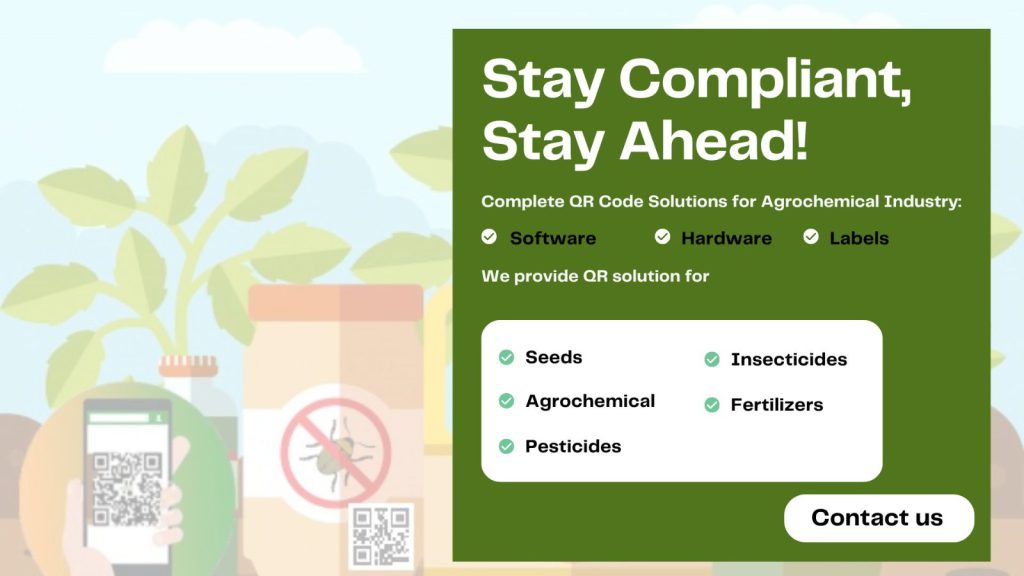
QR code on Labels for Agrochemical
QR Code on Labels for Agrochemical are emerging as a powerful tool in track and trace in various industries across the globe. The evolving QR code regulation in India for pesticides is a step in the right direction in enabling easy access to crucial information about pesticides for farmers, consumers, and regulators. Introducing QR codes for pesticides necessitates a methodical strategy to ensure a successful assimilation and smooth integration. This document presents a comprehensive, step-by-step manual for the incorporation of QR codes in the pesticide domain within India. The intention is to empower stakeholders and advocate for the responsible utilization of pesticides.
Step 1: Policy and Regulatory Framework
The first step in implementing QR codes for pesticides in India is the development of a robust policy and regulatory framework.
The Ministry of Agriculture and farmers welfare through the Gazette notification dated 17th March 2023 has published the draft rules further to amend the Insecticides rule of 1971 and these rules are called the Insecticides (second Amendment) Rules 2023.

In sub-clause (w), after the first proviso, following proviso shall be inserted:
“Provided that QR Code shall be placed on retail pack (Primary or Secondary pack as the case may be) at suitable place where on scanning the QR code by scanning equipment like mobile phone, a web link or link for opening the URL of the Manufacturing company will appear, which on pressing or clicking, will take the user to the entire unique information of label and leaflet and the QR code shall contain at least the following information:
(a) Unique Identifier or GTIN;
(b) Batch Number;
(c) Date of Manufacturing;
(d) Date of Expiry;
(e) Web link or URL.
Step 2: QR Code Generation
The pesticide manufacturers are required to generate QR codes for their products. There are several QR code generation tools and software available in the market that can help create QR codes efficiently. Manufacturers should ensure that the QR codes generated are unique, easy to scan and comply with the government mandated norms and standards.
Step 3: Label Design and Printing
The next step is to incorporate the QR codes onto the product labels. Manufacturers may redesign their product labels to include the QR code. It is necessary to ensure that the QR code is easily visible and positioned for an easy scan without any obstructions. Labels should also contain other mandatory information required by regulatory authorities, such as product name, manufacturer details, batch number, and expiry date.
Step 4: Database Management
To enable the retrieval of accurate information through QR code scanning, pesticides manufacturers must maintain a comprehensive database. This database should contain the product-specific information associated with each QR code, including the composition, usage guidelines, safety precautions, and any updates or revisions. Regular updates to the database will ensure that users receive the most up-to-date information when scanning the QR code.
Step 5: Integration of QR Codes
Once the labels are printed, pesticide manufacturers need to integrate the QR codes onto their products. This process may involve using adhesive stickers or directly printing the QR codes on the labels during the manufacturing process. Manufacturers should ensure that the QR codes are securely placed on the labels, with proper alignment and no damage that could hinder scanning.
Step 6: Awareness and Training
The successful implementation of QR codes for pesticides requires creating awareness and providing training to all stakeholders involved. Farmers, consumers, and distributors should be educated about the benefits of QR codes, how to scan them, the information they can access and usage of QR codes effectively.
Step 7: Monitoring and Compliance
After the implementation of QR codes, regular monitoring and compliance checks are crucial to ensure adherence to the established guidelines and be observant of any updates to the regulations.
It also becomes important for the manufacturer to actively monitor the QR code authentication process along the supply chain. This exercise is indispensable for identifying any untoward or unauthorized activities. Instances wherein a specific QR code undergoes an inordinate number of verifications beyond established thresholds may signify irregularities. In such instances, it becomes incumbent upon pertinent stakeholders to initiate appropriate and judicious interventions.
Conclusion
Implementing QR codes for pesticides in India is a significant step toward promoting transparency, empowering stakeholders, and ensuring responsible pesticide use. By following a systematic approach that encompasses policy development, QR code generation, label design, database management, integration, awareness, and monitoring, India can leverage the power of QR codes to provide easy access to critical information about pesticides. This implementation will play a vital role in protecting the environment, enhancing food safety, and fostering sustainable agricultural practices in the country.